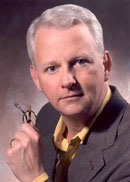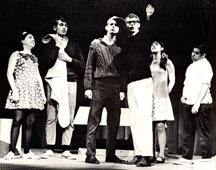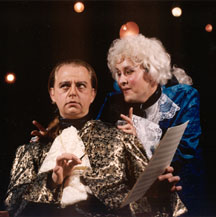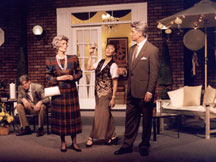
by Michael Craft
Cast requirements:
4 men, 4 women
Scenic requirements:
1 interior (view plan)
Estimated running time:
2 hours, 10 minutes (including intermission)
First scheduled performance:
September 19, 2003 (read premiere details)
Fifty-four and single, Claire Gray has recently embarked upon a new life.
Having lived for some 30 years in New York, where she established herself
as one of Broadway’s most respected directors, she has agreed to
head the theater department of a recently built college near Palm Springs,
California. Settling into her new home, she has now directed her second
major production at Desert Arts College, a revival of her own hit play,
Traders, starring Tanner Griffin, a 26-year-old heartthrob she
has discovered, taught, and mentored.
The powerful film producer Spencer Wallace has seen Tanner act, and he
agrees—Tanner is sensational. In fact, Wallace has signed Tanner
to appear in his next major movie, Photo Flash. Widely known as
Mr. Blockbuster, Wallace has high hopes for this project; he wrote the
script himself, based on his own photography hobby.
Claire couldn’t be prouder, but the trouble is, she and the much younger Tanner have developed an intimate relationship—they’re practically living together—and now that Traders has closed, Tanner will soon be leaving for Hollywood. Claire knows she’s losing him, and in a moment of frustration at the play’s closing-night party, she blurts to Tanner, “I could kill Spencer Wallace for stealing you from me!” Sure enough, after the party, Wallace is found dead in Claire’s swimming pool. Before the curtain falls on scene two, her remarks have been reported to Detective Larry Knoll, who’s investigating the suspicious death.
It was murder, all right, and as details of Wallace’s demise begin to emerge from the investigation, Claire finds herself increasingly under suspicion. But she’s not alone, far from it, and Detective Knoll eventually welcomes her assistance in sorting through the facts and the suspects. It seems everyone had a plausible motive against Wallace—Claire and Tanner; Larry’s campy brother, real-estate developer Grant Knoll; Claire’s zany old chum, costumer Kiki Jasper-Plunkett; the victim’s icy widow, Rebecca Wallace; and her slippery attorney, Bryce Ballantyne. Even the scatterbrained maid is seen in a suspicious light.
At times rollicking and at other times profoundly serious, the show mixes irreverent laughter with Claire’s dawning insights into the classic middle-age riddles of lost youth. These emotional extremes serve to frame the ongoing whodunit, which Claire finally solves in a moment of victory—vowing to restrict her future triumphs to “the theatrical variety.” Somehow, we’re left with the lingering impression that Claire’s sleuthing days have only begun.
The script is appropriate for production by any adult or college troupe.
(Most high school groups would find it difficult to convincingly portray
the crucial age difference between Claire and Tanner, who are romantically
linked.)
 Author’s comments
Author’s comments
I discovered the magic of theater during my sophomore year of high school, and it has been a force in my life ever since. I was extremely active in theater not only in high school at Elgin Academy (Elgin, Illinois), but also in college, at the University of Illinois (Urbana-Champaign). Later, when my day-job career settled down, I came to know the delights of community theater with Lakeside Players in Kenosha, Wisconsin.
Ultimately, however, Photo Flash is as much a character study of Claire Gray as it is a perky whodunit. Claire is a complex gal, struggling with some fairly heavy issues at the personal, emotional level, as delineated in the play’s romantic subplot. This, I hope, is what will set Photo Flash apart from so many other worthy drawing-room dramas. These deeper issues, which are decidedly not comic, are meant to keep audiences thinking—after the curtain falls.
Rights and royalties
Photo Flash is held in copyright by the author, Michael Craft. Production of Photo Flash, whether professional or amateur, is subject to a royalty, which must be paid whether the play is presented for charity or gain and whether or not admission is charged. For information regarding production rights and royalties, or to obtain a sample copy of the script, simply e-mail the author.
Queries regarding all other rights, including film or television development and translation into foreign languages, should be addressed to the author’s agent, Mitchell Waters, at Curtis Brown Ltd., 10 Astor Place, New York NY 10003.
Click
here for a listing of the cast of characters.
Click here for a synopsis of
scenes.
Click here to view the scenic design.
Click here to read
a scene from the Photo Flash script.
Click here for an overview of the Photo
Flash premiere.
Click here to return to main page.



